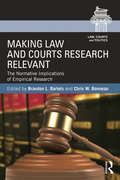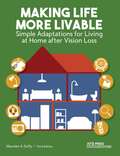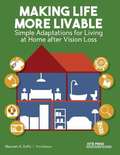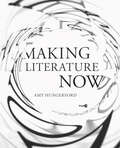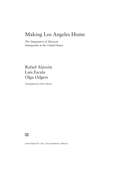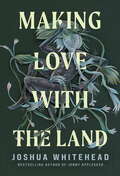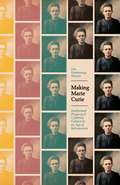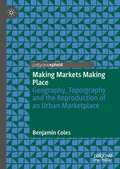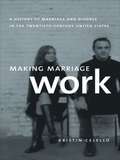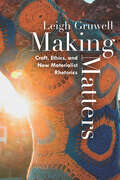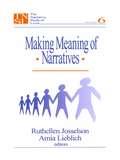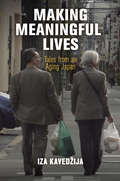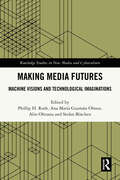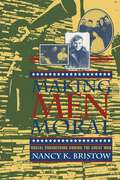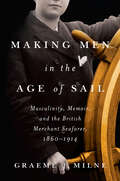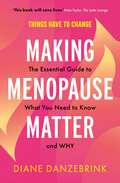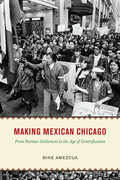- Table View
- List View
Making Kin with Trees: A Cultural Poetics of Interspecies Care (Palgrave Studies in Mediating Kinship, Representation, and Difference)
by Solvejg NitzkeThis book analyzes how trees act as mediators of interspecies relationships in popular science writing and creative nonfiction. Making Kin with Trees argues that trees emerge as agents of &“arboreal poetics&” shaping not only fictional but also material interactions. Following how speculative care practices infuse scientific and poetic texts, formatting practices of reading, sensing, knowing, and communicating (with) trees while affirming both cultural and scientific meaning making processes. This book shows how arboreal thinking connects and might ultimately require breaking down the barrier between fact and fiction, human and plant, onlooker and artwork. This book will be of interest to audiences based in fields including environmental humanities, science and technology studies and ecocriticism, and everyone engaged in science communication and interested in the relationship between scientific fact and narrative.
Making Knowledge: Explorations of the Indissoluble Relation between Mind, Body and Environment (Journal Of The Royal Anthropological Institute Special Issue Book Ser. #5)
by Trevor H. J. MarchandMaking Knowledge presents the work of leading anthropologists who promote pioneering approaches to understanding the nature and social constitution of human knowledge. The book offers a progressive interdisciplinary approach to the subject and covers a rich and diverse ethnography. Presents cutting-edge research and theory in anthropology Includes many beautiful illustrations throughout The contributions cover a rich and diverse ethnography Offers a progressive interdisciplinary approach to the eternal questions concerning ‘human knowledge’ Contributions by leading scholars in the field who explore a wide range of disciplines through an anthropological perspective
Making Law and Courts Research Relevant: The Normative Implications of Empirical Research (Law, Courts and Politics)
by Chris W. Bonneau Brandon L. BartelsOne of the more enduring topics of concern for empirically-oriented scholars of law and courts—and political scientists more generally—is how research can be more directly relevant to broader audiences outside of academia. A significant part of this issue goes back to a seeming disconnect between empirical and normative scholars of law and courts that has increased in recent years. Brandon L. Bartels and Chris W. Bonneau argue that being attuned to the normative implications of one’s work enhances the quality of empirical work, not to mention makes it substantially more interesting to both academics and non-academic practitioners. Their book’s mission is to examine how the normative implications of empirical work in law and courts can be more visible and relevant to audiences beyond academia. Written by scholars of political science, law, and sociology, the chapters in the volume offer ideas on a methodology for communicating normative implications in a balanced, nuanced, and modest manner. The contributors argue that if empirical work is strongly suggestive of certain policy or institutional changes, scholars should make those implications known so that information can be diffused. The volume consists of four sections that respectively address the general enterprise of developing normative implications of empirical research, law and decisionmaking, judicial selection, and courts in the broader political and societal context. This volume represents the start of a conversation on the topic of how the normative implications of empirical research in law and courts can be made more visible. This book will primarily interest scholars of law and courts, as well as students of judicial politics. Other subfields of political science engaging in empirical research will also find the suggestions made in the book relevant.
Making Lemonade out of Lemons: Mexican American Labor and Leisure in a California Town 1880-1960 (Statue of Liberty Ellis Island)
by José M. AlamilloOut of the “lemons” handed to Mexican American workers in Corona, California--low pay, segregated schooling, inadequate housing, and racial discrimination--Mexican men and women made “lemonade” by transforming leisure spaces such as baseball games, parades, festivals, and churches into politicized spaces where workers voiced their grievances, debated strategies for advancement, and built solidarity. Using oral history interviews, extensive citrus company records, and his own experiences in Corona, José Alamillo argues that Mexican Americans helped lay the groundwork for civil rights struggles and electoral campaigns in the post-World War II era.
Making Life More Livable
by Maureen A. DuffyFor more than 30 years, Making Life More Livable has served as an indispensable resource for older adults with vision loss and their families, providing practical tips and easy adaptations and modifications for improving the safety and security of older adults in their homes. The revised and updated third edition includes information on current technology and independent living products, as well as an updated Resource Guide, in addition to general guidelines and room-by-room specifics. A brand new chapter describes basic skills for moving around safely inside the home and provides suggestions for preventing falls. The chapter on additional health conditions has also been expanded to include the specific ways each condition affects vision. The newest edition also has a fresh, vibrant look, with color photos illustrating simple and effective solutions for older adults to continue living independent, productive lives.
Making Life More Livable: Simple Adaptations For Living At Home After Vision Loss
by Maureen A. DuffyFor more than 30 years, Making Life More Livable has served as an indispensable resource for older adults with vision loss and their families, providing practical tips and easy adaptations and modifications for improving the safety and security of older adults in their homes. The revised and updated third edition includes information on current technology and independent living products, as well as an updated Resource Guide, in addition to general guidelines and room-by-room specifics. A brand new chapter describes basic skills for moving around safely inside the home and provides suggestions for preventing falls. The chapter on additional health conditions has also been expanded to include the specific ways each condition affects vision. The newest edition also has a fresh, vibrant look, with color photos illustrating simple and effective solutions for older adults to continue living independent, productive lives.
Making Literature Now
by Amy HungerfordHow does new writing emerge and find readers today? Why does one writer's work become famous while another's remains invisible? Making Literature Now tells the stories of the creators, editors, readers, and critics who make their living by making literature itself come alive. The book shows how various conditions--including gender, education, business dynamics, social networks, money, and the forces of literary tradition--affect the things we can choose, or refuse, to read. Amy Hungerford focuses her discussion on literary bestsellers as well as little-known traditional and digital literature from smaller presses, such as McSweeney's. She deftly matches the particular human stories of the makers with the impersonal structures through which literary reputation is made. Ranging from fine-grained ethnography to polemical argument, this book transforms our sense of how and why new literature appears--and disappears--in contemporary American culture.
Making Long Island: A History of Growth and the American Dream (The History Press)
by Lawrence R. SamuelDiscover the history of the development of Long Island and its intimate relationship with New York City. Beginning in the Roaring Twenties, Wall Street money looked eastward to Nassau and Suffolk counties looking generate wealth from a land boom. After the Great Depression and World War II, Long Island was the site of the creation of the quintessential postwar American suburb, Levittown. Levittown and its spinoff suburban communities served as a primary symbol of the American dream through affordable home ownership for the predominately White middle class and established a core attribute of the national mythology. Starting in the 1960s, the dream began to dissolve, as the postwar economic engine ran out of steam and Long Island became as much urban as suburban. Author Lawrence R. Samuel charts how the island evolved over the decades and largely detached itself from New York City to become a self-sustaining entity with its own challenges, exclusions and triumphs.
Making Los Angeles Home: The Integration of Mexican Immigrants in the United States
by Rafael Alarcón Luis Escala Olga OdgersMaking Los Angeles Home examines the different integration strategies implemented by Mexican immigrants in the Los Angeles region. Relying on statistical data and ethnographic information, the authors analyze four different dimensions of the immigrant integration process (economic, social, cultural, and political) and show that there is no single path for its achievement, but instead an array of strategies that yield different results. However, their analysis also shows that immigrants' successful integration essentially depends upon their legal status and long residence in the region. The book shows that, despite this finding, immigrants nevertheless decide to settle in Los Angeles, the place where they have made their homes.
Making Love with the Land: Essays
by Joshua WhiteheadA moving and deeply personal excavation of Indigenous beauty and passion in a suffering world The novel Jonny Appleseed established Joshua Whitehead as one of the most exciting and important new literary voices on Turtle Island, winning both a Lambda Literary Award and Canada Reads 2021. In Making Love with the Land, his first nonfiction book, Whitehead explores the relationships between body, language, and land through creative essay, memoir, and confession.In prose that is evocative and sensual, unabashedly queer and visceral, raw and autobiographical, Whitehead writes of an Indigenous body in pain, coping with trauma. Deeply rooted within, he reaches across the anguish to create a new form of storytelling he calls &“biostory&”—beyond genre, and entirely sovereign. Through this narrative perspective, Making Love with the Land recasts mental health struggles and our complex emotional landscapes from a nefarious parasite on his (and our) well-being to kin, even a relation, no matter what difficulties they present to us. Whitehead ruminates on loss and pain without shame or ridicule but rather highlights waypoints for personal transformation. Written in the aftermath of heartbreak, before and during the pandemic, Making Love with the Land illuminates this present moment in which both Indigenous and non-Indigenous people are rediscovering old ways and creating new ones about connection with and responsibility toward each other and the land.Intellectually audacious and emotionally compelling, Whitehead shares his devotion to the world in which we live and brilliantly—even joyfully—maps his experience on the land that has shaped stories, histories, and bodies from time immemorial.
Making Marie Curie: Intellectual Property and Celebrity Culture in an Age of Information
by Eva Hemmungs WirténIn many ways, Marie Curie represents modern science. Her considerable lifetime achievements--the first woman to be awarded a Nobel Prize, the only woman to be awarded the Prize in two fields, and the only person to be awarded Nobel Prizes in multiple sciences--are studied by schoolchildren across the world. When, in 2009, the New Scientist carried out a poll for the "Most Inspirational Female Scientist of All Time," the result was a foregone conclusion: Marie Curie trounced her closest runner-up, Rosalind Franklin, winning double the number of Franklin's votes. She is a role model to women embarking on a career in science, the pride of two nations--Poland and France--and, not least of all, a European Union brand for excellence in science. Making Marie Curie explores what went into the creation of this icon of science. It is not a traditional biography, or one that attempts to uncover the "real" Marie Curie. Rather, Eva Hemmungs Wirtén, by tracing a career that spans two centuries and a world war, provides an innovative and historically grounded account of how modern science emerges in tandem with celebrity culture under the influence of intellectual property in a dawning age of information. She explores the emergence of the Curie persona, the information culture of the period that shaped its development, and the strategies Curie used to manage and exploit her intellectual property. How did one create and maintain for oneself the persona of scientist at the beginning of the twentieth century? What special conditions bore upon scientific women, and on married women in particular? How was French identity claimed, established, and subverted? How, and with what consequences, was a scientific reputation secured? In its exploration of these questions and many more, Making Marie Curie provides a composite picture not only of the making of Marie Curie, but the making of modern science itself.
Making Markets Making Place: Geography, Topo/graphy and the Reproduction of an Urban Marketplace
by Benjamin ColesThis book examines place and place-making in London’s Borough Market. In particular, it uses topo/graphy (‘place-writing) to interrogate the ways in which Borough Market’s material, social-sensual and discursive relations assemble to reproduce Borough Market as a place, market and marketplace. Its central premise is that market-processes – the negotiation and exchange of commodities –are place-processes. This means that the often-abstract relationships that ultimately define what we think of as the economy are embedded in the rich and every materiality, sociality, sensuality and meanings associated with place. By tracing out these different elements, topo/graphy illustrates the ways in which economic reproduction is grounded in particular and often discrete practices. However, by assembling them together, this highlights the ways in which place and place-making are the driving force behind the economy at large.
Making Marriage Work: A History of Marriage and Divorce in the Twentieth-Century United States
by Kristin CelelloBy the end of World War I, the skyrocketing divorce rate in the United States had generated a deep-seated anxiety about marriage. This fear drove middle-class couples to seek advice, both professional and popular, in order to strengthen their relationships. InMaking Marriage Work, historian Kristin Celello offers an insightful and wide-ranging account of marriage and divorce in America in the twentieth century, focusing on the development of the idea of marriage as "work. " Examining the marriage counseling profession, advice columns in women's magazines, movies, and television shows, Celello describes how professionals and the public worked together to define the nature of marital work throughout the twentieth century. She also demonstrates that the maxim of "working at marriage" often masked important inequalities in regard to men's and women's roles within marriage. Most experts, for instance, assumed that women needed marriage more than men and thus held wives accountable for marital success or failure. Making Marriage Workpresents a new interpretation of married life in the United States, illuminating the interaction of marriage and divorce over the century and revealing how the idea that marriage requires work became part of Americans' collective consciousness.
Making Matters: Craft, Ethics, and New Materialist Rhetorics
by Leigh GruwellCraft is a process-oriented practice that takes seriously the relationships between bodies—both human and nonhuman—and makes apparent how these relationships are mired in and informed by power structures. Making Matters introduces craft agency, a feminist vision of new materialist rhetorics that enables scholars to identify how power circulates and sometimes stagnates within assemblages of actors and provides tools to rectify that uneven distribution. To recast new materialist rhetorics as inherently crafty, Leigh Gruwell historicizes and locates the concept of craft both within rhetorical history as well as in the disciplinary history of writing studies. Her investigation centers on three specific case studies: craftivism, the fibercraft website Ravelry, and the 2017 Women’s March. These instances all highlight how a material, ecological understanding of rhetorical agency can enact political change. Craft agency models how we humans might work with and alongside things—nonhuman, sometimes digital, sometimes material—to create more equitable relationships. Making Matters argues that craft is a useful starting point for addressing criticisms of new materialist rhetorics not only because doing so places rhetorical action as a product of complex relationships between a network of human and nonhuman actors, but also because it does so with an explicitly activist agenda that positions the body itself as a material interface.
Making Meaning of Narratives
by Dr Ruthellen H. Josselson Dr Amia LieblichThe sixth volume in this series provides: guides for doing qualitative research; analysis of several autobiographies; hints on how to interpret what is not said in narrative interviews; discussion on how cultural meanings and values are transmitted across generations; and illustrations of the transformational power of stories.
Making Meaningful Lives: Tales from an Aging Japan (Contemporary Ethnography)
by Iza KavedžijaWhat makes for a meaningful life? In the Japanese context, the concept of ikigai provides a clue. Translated as "that which makes one's life worth living," ikigai has also come to mean that which gives a person happiness. In Japan, where the demographic cohort of elderly citizens is growing, and new modes of living and relationships are revising traditional multigenerational family structures, the elderly experience of ikigai is considered a public health concern. Without a relevant model for meaningful and joyful older age, the increasing older population of Japan must create new cultural forms that center the ikigai that comes from old age.In Making Meaningful Lives, Iza Kavedžija provides a rich anthropological account of the lives and concerns of older Japanese women and men. Grounded in years of ethnographic fieldwork at two community centers in Osaka, Kavedžija offers an intimate narrative analysis of the existential concerns of her active, independent subjects. Alone and in groups, the elderly residents of these communities make sense of their lives and shifting ikigai with humor, conversation, and storytelling. They are as much providers as recipients of care, challenging common images of the elderly as frail and dependent, while illustrating a more complex argument: maintaining independence nevertheless requires cultivating multiple dependences on others. Making Meaningful Lives argues that an anthropology of the elderly is uniquely suited to examine the competing values of dependence and independence, sociality and isolation, intimacy and freedom, that people must balance throughout all of life's stages.
Making Media Futures: Machine Visions and Technological Imaginations (Routledge Studies in New Media and Cyberculture)
by Alin Olteanu Stefan Böschen Phillip H. Roth Ana María Guzmán OlmosMaking Media Futures offers a multi-perspectival exploration of how imaginaries and knowledge of the future are constructed in and through various media.The volume addresses the discursive dimensions of imaginaries and future visions as well as the impact of technological, material, and cultural conditions on the propagation of future discourses through media. Providing both theoretically detailed and empirically rich investigations, the contributions offer a wide range of cases spanning the century from the end of World War II until today and looking at examples from the Southern Hemisphere as well as the Global North. Bringing together scholars in media studies, science and technology studies (STS), and the history and philosophy of technology, the chapters discuss future visions and imaginations of quantum computing, the uncertainty and impact of AI-based text-to-image generation, the ideology behind 5G telecommunication standards, imaginaries of the Internet of Things, transmedia strategies in global and local climate protests, how broadcast radio was implicated in the evangelical mission imaginary, and how early visions of automating scholarly information management shaped standards and ideals of academia. The volume thus complements existing approaches and analytical frameworks for the study of imaginaries and futures discourses with perspectives that are sensitive to the plurality of media-specific conditions and technologies.The book will interest students and scholars working in media studies, STS, history and philosophy as well as at the intersection of engineering, humanities and social sciences, on matters such as sustainability, ethics, and responsible innovation.
Making Media Matter: Critical Literacy, Popular Culture, and Creative Production
by Benjamin TheveninThis book is an essential resource for media educators working to promote critical thinking, creativity, and civic engagement through their teaching. Connecting theory and research with creative projects and analyses of pop culture, it models an integrated and practical approach to media education. In order to prepare learners to successfully navigate rapid shifts in digital technology and popular culture, media educators in both secondary and university settings need to develop fresh, innovative approaches. Integrating concepts and practices from the fields of media studies, media arts, and media literacy, this book prepares teachers to help their students make connections between their studies, uses of media, creative expression, and political participation. As educators implement the strategies in this book in their curricula and pedagogy, they will be empowered to help their students more thoughtfully engage with media culture and use their intelligence and imagination to address pressing challenges facing our world today. Making Media Matter is an engaging and accessible read for educators and scholars in the areas of media literacy, media and cultural studies, media arts, and communication studies.
Making Media: Production, Practices, and Professions
by Mark Deuze Mirjam PrengerMaking Media' uncovers what it means and what it takes to make media, focusing on the lived experience of media professionals within the global media, including rich case studies of the main media industries and professions: television, journalism, social media entertainment, advertising and public relations, digital games, and music. This carefully edited volume features 35 authoritative essays by 53 researchers from 14 countries across 6 continents, all of whom are at the cutting edge of media production studies. The book is particularly designed for use in coursework on media production, media work, media management, and media industries. Specific topics highlighted:the history of media industries and production studies; production studies as a field and a research method; changing business models, economics, and management; global concentration and convergence of media industries and professions; the rise and role of startups and entrepreneurship; freelancing in the digital age; the role of creativity and innovation; the emotional quality of media work; diversity and inequality in the media industries. Open Uva CourseThe University of Amsterdam has a open course around the book. The course offers a review of the key readings and debates in media production studies.
Making Megacities in Asia: Comparing National Economic Development Trajectories (SpringerBriefs in Regional Science)
by Du HuynhThis book analyses and compares the development paths of five major cities in East and Southeast Asia since the early 1960s, including Ho Chi Minh City, Jakarta, Manila, Seoul, and Shanghai. In examining these five cases through a carefully crafted conceptual framework, the author excavates an understanding of the dynamics that have enabled Seoul and Shanghai to become highly competitive as major engines of economic growth, while simultaneously accounting for why the other three cities have faced numerous problems in terms of meeting their development goals. Presenting both quantitative and qualitative data to trace the course of changes between 1960 and 2015, the case studies curate six possible explanations for the different cities’ developmental trajectories. The book considers the national development strategy matters to the development of cities and positions the share of budget revenue retained for cities’ expenditure as critical. The author demonstrates that consistently pursuing long-term strategies is important, and that public entrepreneurship with powerful supporting coalitions is vital. The book illustrates how master plans have played limited roles in the building of cities, and that fragmented governments are often at the root of the problems facing a city’s development. This book will be highly relevant to researchers in international and Asian urban development.
Making Men Moral: Social Engineering During the Great War (The American Social Experience #8)
by Nancy K. BristowOn May 29, 1917, Mrs. E. M. Craise, citizen of Denver, Colorado, penned a letter to President Woodrow Wilson, which concluded, We have surrendered to your absolute control our hearts' dearest treasures--our sons. If their precious bodies that have cost us so dear should be torn to shreds by German shot and shells we will try to live on in the hope of meeting them again in the blessed Country of happy reunions. But, Mr. President, if the hell-holes that infest their training camps should trip up their unwary feet and they be returned to us besotted degenerate wrecks of their former selves cursed with that hell-born craving for alcohol, we can have no such hope. Anxious about the United States' pending entry into the Great War, fearful that their sons would be polluted by the scourges of prostitution, venereal disease, illicit sex, and drink that ran rampant in the training camps, countless Americans sent such missives to their government officials. In response to this deluge, President Wilson created the Commission on Training Camp Activities to ensure the purity of the camp environment. Training camps would henceforth mold not only soldiers, but model citizens who, after the war, would return to their communities, spreading white, urban, middle-class values throughout the country. What began as a federal program designed to eliminate sexually transmitted diseases soon mushroomed into a powerful social force intent on replacing America's many cultures with a single, homogenous one. Though committed to the positive methods of education and recreation, the reformers did not hesitate to employ repression when necessary. Those not conforming to the prescribed vision of masculinity often faced exclusion from the reformers' idealized society, or sometimes even imprisonment. Social engineering ruled the day. Combining social, cultural, and military history and illustrating the deep divisions among reformers themselves, Nancy K. Bristow, with the aid of dozens of evocative photographs, here brings to life a pivotal era in the history of the U.S., revealing the complex relationship between the nation's competing cultures, progressive reform efforts, and the Great War.
Making Men in the Age of Sail: Masculinity, Memoir, and the British Merchant Seafarer, 1860–1914
by Graeme J. MilneMyths and stereotypes surrounding seafarers in the Age of Sail persist to this day. Sailors were celebrated for their courage, strength, and skill, yet condemned for militancy, vice, and fecklessness. As sail gave way to steam, sailing-ship mariners became nostalgic symbols of maritime prowess and heritage, representing a timeless, heroic masculinity in an era when the modernizing industrial world was challenging assumptions about gender, class, work, and society.Drawing on British seafaring memoirs from the late nineteenth century, Making Men in the Age of Sail argues that maritime writing moulded the reading public’s image of the merchant seaman. Authors chronicled their lives as they grew from boy sailors to trained seafarers, telling colourful tales of the men they worked with – most never doubted that the sailing ship had made them better men. Their testimony reinforced and preserved conservative perspectives on seafaring manhood as Britain’s economic and technological priorities continued to evolve in the new steamship age.Offering a gender analysis of the image of the seafarer, Making Men in the Age of Sail brings the history of British sailors into wider debates about modernity and masculinity.
Making Menopause Matter: The Essential Guide to What You Need to Know and Why
by Diane DanzebrinkIn recent years, the conversation around menopause has opened up; most of us understand what menopause means, and that it can be more than a few hot flushes and periods stopping. BUT.Do we really know why menopause matters?Menopause will directly affect approximately half the world's population, and will indirectly affect the other half, too. There is a huge diversity of experiences that can potentially impact both short- and long-term physical, cognitive and emotional health and wellbeing, careers, relationships, families, friendships and finances. How do you, your mother, your sister, your friends or your partner get the help and support that they need in all aspects of their lives, throughout the menopause transition and beyond? Diane's book can answer that - and so much more. Diane Danzebrink was one of the first people to campaign for better menopause education, care, and support. Her work has been critical in ensuring that menopause is now part of the RSE curriculum in schools in England, and to the way in which menopause is no longer seen as a shameful or trivial experience. Her book, Making Menopause Matter, guides us through all aspects of the menopause landscape; it reminds us not only of what menopause is - its scope, nature and potential impact - but also why it is important that we continue to call for access to support for all, enhanced understanding, and an acceptance that menopause is an individual experience. While it may not be a seamless transition, menopause does offer an important opportunity when the right help and support is in place. Diane's wise, compassionate writing offers practical advice along with deeper insights into how we can better support ourselves and those we know and love when their lives are impacted by menopause. Part manifesto, a little memoir, plenty of self-help and ultimately a call to arms for society, public health and individuals alike, Making Menopause Matter should be required reading for all.
Making Mexican Chicago: From Postwar Settlement to the Age of Gentrification (Historical Studies of Urban America)
by Mike AmezcuaAn exploration of how the Windy City became a postwar Latinx metropolis in the face of white resistance. Though Chicago is often popularly defined by its Polish, Black, and Irish populations, Cook County is home to the third-largest Mexican-American population in the United States. The story of Mexican immigration and integration into the city is one of complex political struggles, deeply entwined with issues of housing and neighborhood control. In Making Mexican Chicago, Mike Amezcua explores how the Windy City became a Latinx metropolis in the second half of the twentieth century. In the decades after World War II, working-class Chicago neighborhoods like Pilsen and Little Village became sites of upheaval and renewal as Mexican Americans attempted to build new communities in the face of white resistance that cast them as perpetual aliens. Amezcua charts the diverse strategies used by Mexican Chicagoans to fight the forces of segregation, economic predation, and gentrification, focusing on how unlikely combinations of social conservatism and real estate market savvy paved new paths for Latinx assimilation. Making Mexican Chicago offers a powerful multiracial history of Chicago that sheds new light on the origins and endurance of urban inequality.
Making Mexican Chicago: From Postwar Settlement to the Age of Gentrification (Historical Studies of Urban America)
by Mike AmezcuaAn exploration of how the Windy City became a postwar Latinx metropolis in the face of white resistance. Though Chicago is often popularly defined by its Polish, Black, and Irish populations, Cook County is home to the third-largest Mexican-American population in the United States. The story of Mexican immigration and integration into the city is one of complex political struggles, deeply entwined with issues of housing and neighborhood control. In Making Mexican Chicago, Mike Amezcua explores how the Windy City became a Latinx metropolis in the second half of the twentieth century. In the decades after World War II, working-class Chicago neighborhoods like Pilsen and Little Village became sites of upheaval and renewal as Mexican Americans attempted to build new communities in the face of white resistance that cast them as perpetual aliens. Amezcua charts the diverse strategies used by Mexican Chicagoans to fight the forces of segregation, economic predation, and gentrification, focusing on how unlikely combinations of social conservatism and real estate market savvy paved new paths for Latinx assimilation. Making Mexican Chicago offers a powerful multiracial history of Chicago that sheds new light on the origins and endurance of urban inequality.


